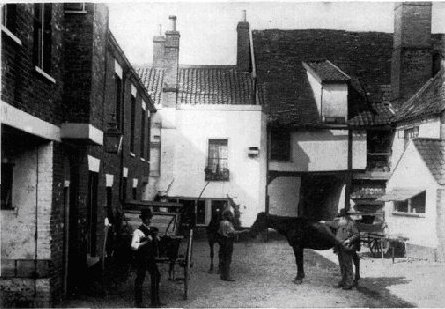
The George Hotel
In the 16th and 17th centuries there were many records of the catholic sympathy shown by the good folk of Watton to those in trouble in other parts of the country and in 1666 £2. 12. 0 was given for the relief of the poor in the Great Fire of London. In May 1677 15s. 6d. was given for those who suffered in the dreadful fire at Northampton and similar donations were sent to many other places that suffered from fire, hail storms, gales and floods. By the time Elizabeth I ascended the throne Watton was already the proud possessor of a Market Cross which was supported by eight oak pillars. Between two of them, on the south side, were placed the stocks and immediately above them was the Town's name, carved in Oak, "A Hare and a TUN". The Cross was taken down in 1820 and replaced by a "Stone Obelisk" marked with the distance to the neighbouring market towns. During Elizabeth's reign 1558-1603 a number of inns had been built near the town centre and the famous "George Coaching Hotel" which occupied the site of the present Lloyd's Bank, was already in existence. During the coaching era the Norwich to London Stage Coach changed horses at the George Hotel and the Holt to Thetford Coach also picked up passengers here. Other Inns situated near the Market Place included the "Angel", "Christopher", "Swann", "Griffin", and the "Bull", but not the present "Bull Hotel", although this earlier inn probably stood on the same site. A number of crafts, trades and businesses flourished in Watton during the 16th and 17th century including, butchers, bakers, brewers, shoemakers, blacksmiths, wheelwrights, saddlers and coopers. But by far the most important industry was the manufacture of woollen cloth and the most influential men were the mercers who dealt in this business. One of the most prosperous of them was Christopher Hey who built the town's most distinctive landmark, the Clock Tower. The only known trade token for the town was issued by him. On one side it had his name and the Mercer's Arms and on the other side was the inscription "of Watton, Mercer C.M.H." Many of the mercers and some of the craftsmen were also landowners and farmers and some of their farm buildings were situated within a hundred yards or so of the Market Cross and agriculture was thus the main employer of labour. |

